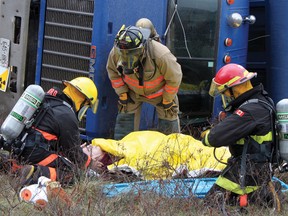Mock disaster training

Article content
LAURENTIAN HILLS - A collision involving a tractor trailer, pick-up truck and car on the Trans-Canada Highway, is a calamity where precious minutes mean the difference between life and death.
Then consider the dangerous contents of the transport - a shipment of radioactive material. The rise to the victims and their rescuers couldn’t be greater.
This nightmare scenario was played out in the former Canadian Pacific Rail yard in Chalk River Friday morning as Atomic Energy of Canada Limited (AECL) joined other regional first responders in a real-time, joint emergency response training exercise.
The simulation of emergency events is an effective way for emergency response agencies to improve their ability to work together and ensure a timely, well-coordinated response during a real situation. This was the theme of this mock disaster where all participants exercise their understanding of unified command - the concept that brings together the incident commanders of all major organizations involved in an emergency in order to coordinate an effective response while at the same time carrying out their own Leslie Wirth, deputy chief of the County of Renfrew Paramedic Service, said unified command is an essential part of all mock exercises conducted by first responders during the year.
“They’ve been fundamental in improving our response throughout the community,” said Wirth.
The exercise included members of the County of Renfrew Paramedic Service, the Laurentian Hills and Deep River fire departments, the Upper Ottawa Valley detachment of the Ontario Provincial Police, the Town of Deep River Police Department and the Ministry of Health and Long Term Care - Central Ambulance Communications Centre. Joining these agencies for this particular scenario was the Atomic Energy Radiological Emergency Response Team. Wirth said the situation presented here is a realistic one.
“There’s numerous vehicles transporting radioactive material everyday on the highway so this is very likely,” she said.
The paramedic service had been training over the past month on how to respond to a bio-hazardous scene. On this occasion, the paramedics set up a triage area far from the accident scene and suited up wearing personal protective equipment.
“We will learn a lot here,” said Wirth. “The goal is to improve our response.”
Sean Chase is a Daily Observer multimedia journalist responsibilities.